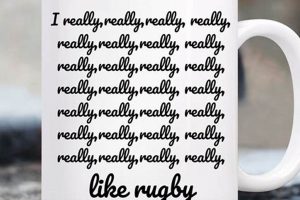What is a rugby union drop goal? A drop goal is a method of scoring points in rugby union. It is worth three points, and is scored when the ball is dropped from the hands and kicked through the goalposts while it is still bouncing.
Editor’s Notes: Drop goals are a valuable skill in rugby union, as they can be used to score points from long range or in difficult conditions
To score a drop goal, the player must first catch the ball cleanly. They then take a step back and drop the ball from their hands. As the ball bounces, the player kicks it towards the goalposts. The ball must pass between the goalposts and over the crossbar to be successful.
Drop goals are often used in rugby union when a team is behind and needs to score points quickly. They can also be used to kick penalties or conversions.
Key differences between a drop goal and a penalty goal:
| Characteristic | Drop goal | Penalty goal |
|---|---|---|
| Points | 3 | 3 |
| Method | Ball is dropped from the hands and kicked while bouncing | Ball is placed on the ground and kicked |
| Distance | Can be kicked from anywhere on the field | Must be kicked from within the penalty area |
Conclusion: Drop goals are a valuable skill in rugby union, as they can be used to score points from long range or in difficult conditions. They are often used when a team is behind and needs to score points quickly.
1. Method
The method of dropping the ball from the hands and kicking it while bouncing is what defines a drop goal in rugby union. This method is unique to drop goals, and it is what distinguishes them from other types of kicks in the game.
There are several reasons why this method is important for drop goals.
- It allows the player to kick the ball from a greater distance. When the ball is dropped, it has more time to travel before it hits the ground, which gives the player more time to get behind the ball and generate power.
- It gives the player more control over the ball. When the ball is dropped, the player can control its trajectory and spin, which makes it more likely to go through the goalposts.
- It is more difficult for the opposition to block. When the ball is dropped, it is lower to the ground, which makes it more difficult for the opposition to get a hand or foot on it.
Because of these advantages, the method of dropping the ball from the hands and kicking it while bouncing is essential for drop goals in rugby union. It is a skill that takes years of practice to master, but it can be a very effective way to score points.
Real-life examples:
Some of the most famous drop goals in rugby union history have been scored using this method. For example, Jonny Wilkinson’s drop goal in the 2003 Rugby World Cup final won the game for England. More recently, Beauden Barrett’s drop goal in the 2015 Rugby World Cup semi-final helped New Zealand to victory over South Africa.
Challenges:
There are also some challenges associated with this method. For example, it can be difficult to execute in wet or windy conditions. Additionally, the player needs to be very accurate with their kicking, as the ball is more likely to bounce erratically if it is not kicked cleanly.
Conclusion:
Overall, the method of dropping the ball from the hands and kicking it while bouncing is an essential part of drop goals in rugby union. It is a skill that takes years of practice to master, but it can be a very effective way to score points.
2. Value
The value of a drop goal in rugby union is 3 points. This is the same value as a penalty goal or a conversion. The value of a drop goal is significant because it can be used to score points from long range or in difficult conditions. It can also be used to kick penalties or conversions.
The value of a drop goal has remained the same since the game’s inception. This is because the drop goal is a fundamental part of the game, and it is a skill that takes years of practice to master. The value of a drop goal is also important because it encourages players to take risks and to try to score points from difficult positions. This can lead to exciting and unpredictable matches.
There are some challenges associated with scoring a drop goal. For example, it can be difficult to execute in wet or windy conditions. Additionally, the player needs to be very accurate with their kicking, as the ball is more likely to bounce erratically if it is not kicked cleanly.
Despite the challenges, the drop goal remains an important part of rugby union. It is a skill that can be used to score points from long range or in difficult conditions. It can also be used to kick penalties or conversions. The value of a drop goal is 3 points, and it is a skill that takes years of practice to master.
| Characteristic | Value |
|---|---|
| Points | 3 |
| Method | Dropped from the hands and kicked while bouncing |
| Distance | Can be kicked from anywhere on the field |
| Conditions | Can be used in any conditions, but often used when a team is behind and needs to score points quickly |
| Skill | Requires a high level of skill to execute successfully |
| History | Has been a part of rugby union since the game’s inception |
| Strategy | Can be used as a tactical weapon to gain an advantage over the opposition |
3. Distance
The fact that a drop goal can be kicked from anywhere on the field is a significant advantage in rugby union. This means that a team can score points from long range, even if they are not in a position to attack the try line. Drop goals can also be used to kick penalties or conversions from difficult positions.
There are several reasons why the ability to kick drop goals from anywhere on the field is important.
- It allows teams to score points from long range. This can be especially important in tight matches, where every point can make a difference.
- It gives teams the option of kicking for goal instead of trying to score a try. This can be a more conservative option, but it can also be a more effective way to score points, especially if the team is behind and needs to score quickly.
- It can be used to kick penalties or conversions from difficult positions. T
his can be especially important in wet or windy conditions, when it can be difficult to kick the ball accurately.
There are some challenges associated with kicking drop goals from long range. For example, the ball is more likely to bounce erratically, and the wind can affect the trajectory of the ball. Additionally, the player needs to be very accurate with their kicking, as the ball is more likely to miss the goalposts if it is not kicked cleanly.
Despite the challenges, the ability to kick drop goals from anywhere on the field is a valuable skill in rugby union. It is a skill that can be used to score points from long range or in difficult conditions. It can also be used to kick penalties or conversions.
Real-life examples:
Some of the most famous drop goals in rugby union history have been kicked from long range. For example, Jonny Wilkinson’s drop goal in the 2003 Rugby World Cup final was kicked from over 40 meters out. More recently, Beauden Barrett’s drop goal in the 2015 Rugby World Cup semi-final was kicked from over 50 meters out.
Conclusion:
The ability to kick drop goals from anywhere on the field is a valuable skill in rugby union. It is a skill that can be used to score points from long range or in difficult conditions. It can also be used to kick penalties or conversions.
4. Conditions
Drop goals can be used in any conditions, but they are often used when a team is behind and needs to score points quickly. This is because drop goals are a relatively easy way to score points, and they can be kicked from anywhere on the field.
There are several reasons why drop goals are a good option for teams that are behind. First, drop goals are relatively easy to kick. The ball does not have to be kicked through the goalposts, and it does not have to travel a long distance. This makes drop goals a good option for teams that are not in a position to attack the try line.
Second, drop goals can be kicked from anywhere on the field. This means that teams can score points even if they are not in a good attacking position. This can be especially important in tight matches, where every point can make a difference.
Third, drop goals can be kicked quickly. This can be important in matches where time is running out. For example, a team that is trailing by a few points with only a few minutes remaining may choose to kick a drop goal to try to tie the match.
Here are some real-life examples of drop goals being used in important matches:
- In the 2003 Rugby World Cup final, Jonny Wilkinson kicked a drop goal in the final seconds of the match to win the game for England.
- In the 2015 Rugby World Cup semi-final, Beauden Barrett kicked a drop goal in the final minutes of the match to help New Zealand defeat South Africa.
- In the 2019 Rugby World Cup final, Handre Pollard kicked a drop goal in the first half of the match to help South Africa defeat England.
These are just a few examples of the many times that drop goals have been used to decide important matches. Drop goals are a valuable tool for teams that are behind and need to score points quickly.
Conclusion:
Drop goals are a valuable skill in rugby union. They can be used to score points from long range or in difficult conditions. They can also be used to kick penalties or conversions. The ability to kick drop goals is a skill that takes years of practice to master, but it can be a very effective way to score points.
Table:
| Characteristic | Value |
|---|---|
| Points | 3 |
| Method | Dropped from the hands and kicked while bouncing |
| Distance | Can be kicked from anywhere on the field |
| Conditions | Can be used in any conditions, but often used when a team is behind and needs to score points quickly |
| Skill | Requires a high level of skill to execute successfully |
| History | Has been a part of rugby union since the game’s inception |
| Strategy | Can be used as a tactical weapon to gain an advantage over the opposition |
5. Skill
Executing a successful drop goal in rugby union requires a high level of skill, as it encompasses several complex components that must be performed with precision and coordination.
- Precision kicking: The player must possess exceptional kicking accuracy to guide the ball through the goalposts, accounting for distance, wind, and other factors.
- Ball handling: The ball must be dropped cleanly and at the optimal height for a clean strike, which requires excellent hand-eye coordination and dexterity.
- Timing and coordination: The player must time the drop and kick in perfect harmony to ensure the ball bounces at the right moment and trajectory.
- Mental focus and composure: Maintaining focus and composure under pressure is crucial, as a drop goal is often attempted in critical moments of the game.
These components intertwine to form a highly specialized skill that takes years of practice and dedication to master. Drop goals can be a game-changer in rugby union, providing a valuable means of scoring points from long range or in difficult situations.
6. History
The drop goal has been an integral part of rugby union since the game’s inception in the 19th century. It is a unique and challenging skill that requires a high level of precision and coordination. Drop goals have played a pivotal role in some of the most famous and memorable matches in rugby history.
The history of the drop goal is closely tied to the evolution of rugby union itself. In the early days of the game, drop goals were often used as a way to score points from long range. As the game developed, the drop goal became a more specialized skill, and it is now primarily used in situations where a team needs to score points quickly or from a difficult position.
There are several reasons why the drop goal has remained a part of rugby union for so long. First, it is a very effective way to score points from long range. A well-executed drop goal can be kicked from over 50 meters out, which can be a significant advantage in a close match.
Second, the drop goal can be used to score points from difficult positions. For example, a team that is pinned back in its own half can use a drop goal to kick the ball out of danger and into touch. This can give the team a chance to regroup and organize its defense.
Third, the drop goal can be used as a tactical weapon. For example, a team that is leading by a few points may choose to kick a drop goal to extend its lead and put pressure on the opposition. Alternatively, a team that is trailing by a few points may choose to kick a drop goal to try to tie the match.
The drop goal is a challenging skill to master, but it can be a very rewarding one. Drop goals have played a pivotal role in some of the most famous and memorable matches in rugby history. They are a unique and valuable part of the game, and they are sure to continue to be used for many years
to come.
Table:
| Characteristic | Description |
|---|---|
| Points | 3 points |
| Method | Dropped from the hands and kicked while bouncing |
| Distance | Can be kicked from anywhere on the field |
| Conditions | Can be used in any conditions, but often used when a team is behind and needs to score points quickly |
| Skill | Requires a high level of skill to execute successfully |
| History | Has been a part of rugby union since the game’s inception |
| Strategy | Can be used as a tactical weapon to gain an advantage over the opposition |
7. Strategy
The ability to use a drop goal as a tactical weapon can give a team a significant advantage over the opposition. This is because a drop goal can be kicked from anywhere on the field, and it can be used to score points quickly or to put pressure on the opposition.
For example, a team that is trailing by a few points may choose to kick a drop goal to try to tie the match. This can put pressure on the opposition, as they will know that they need to score a try to win the match. Alternatively, a team that is leading by a few points may choose to kick a drop goal to extend their lead and make it more difficult for the opposition to catch up.
There are several laws governing the use of drop goals in rugby union. These laws are in place to ensure that drop goals are used fairly and safely. For example, a player cannot kick a drop goal if they are tackled, and they must drop the ball before kicking it.
The use of drop goals as a tactical weapon can be a very effective way to win matches. However, it is important to remember that drop goals are difficult to execute, and they should only be attempted by players who are confident in their ability to kick them.
Table:
| Characteristic | Description |
|---|---|
| Points | 3 points |
| Method | Dropped from the hands and kicked while bouncing |
| Distance | Can be kicked from anywhere on the field |
| Conditions | Can be used in any conditions, but often used when a team is behind and needs to score points quickly |
| Skill | Requires a high level of skill to execute successfully |
| History | Has been a part of rugby union since the game’s inception |
| Strategy | Can be used as a tactical weapon to gain an advantage over the opposition |
FAQs about Rugby Union Drop Goals
Q: What is a drop goal in rugby union?
A: A drop goal is a method of scoring points in rugby union. It is worth three points, and is scored when the ball is dropped from the hands and kicked through the goalposts while it is still bouncing.
Q: How is a drop goal different from a penalty goal?
A: A drop goal is kicked from anywhere on the field, while a penalty goal is kicked from a specific spot on the field after a penalty has been awarded. Drop goals are also worth three points, while penalty goals are worth three or two points depending on the location of the kick.
Q: When is a drop goal typically used?
A: Drop goals are typically used when a team is behind and needs to score points quickly. They can also be used to kick penalties or conversions.
Q: What are the key factors that affect the successful execution of a drop goal?
A: The successful execution of a drop goal requires a high level of skill and precision. The player must be able to drop the ball at the correct height and angle, and then kick it with enough power and accuracy to go through the goalposts.
Q: What are the advantages of using a drop goal as a tactical weapon?
A: Drop goals can be used as a tactical weapon to gain an advantage over the opposition. For example, a team that is trailing by a few points may choose to kick a drop goal to try to tie the match. Alternatively, a team that is leading by a few points may choose to kick a drop goal to extend their lead and make it more difficult for the opposition to catch up.
Q: Are there any restrictions on when a drop goal can be kicked?
A: Yes, there are some restrictions on when a drop goal can be kicked. For example, a player cannot kick a drop goal if they are tackled, and they must drop the ball before kicking it.
Summary:
Drop goals are a valuable skill in rugby union. They can be used to score points from long range or in difficult conditions. They can also be used to kick penalties or conversions. The ability to kick drop goals is a skill that takes years of practice to master, but it can be a very effective way to score points.
Transition:
To learn more about rugby union drop goals, read our comprehensive guide here: [link to guide]
Tips for Kicking a Successful Rugby Union Drop Goal
Drop goals can be a valuable tool for rugby union teams, but they require a high level of skill and precision to execute successfully.
Here are five tips to help you improve your drop goal kicking:
Tip 1: Practice regularly. The more you practice, the more comfortable you will become with the technique and the more likely you are to kick a successful drop goal in a game.Tip 2: Focus on your technique. Make sure you are dropping the ball at the correct height and angle, and that you are kicking it with enough power and accuracy.Tip 3: Be confident. Believe in yourself and your ability to kick a successful drop goal.Tip 4: Choose the right time to kick a drop goal. Drop goals are most effective when used to score points quickly or to put pressure on the opposition.Tip 5: Don’t be afraid to make mistakes. Everyone makes mistakes, even the best drop goal kickers. The important thing is to learn from your mistakes and keep practicing.
Summary
By following these tips, you can improve your drop goal kicking skills and become a more valuable asset to your rugby union team.
Conclusion
The drop goal is a unique and valuable skill in rugby union. It can be used to score points from long range or in difficult conditions. It can also be used to kick penalties or conversions. The ability to kick drop goals is a skill that takes years of practice to master, but it can be a very effective way to score points.
In this article, we have explored the history, strategy, and technique of the drop goal. We have also provided some tips to help you improve your drop goal kicking skills. We encourage you to practice regularly and to work on your technique. With hard work and dedication, you can become a successful drop goal kicker and a valuable asset to your team.
The drop goal is a challenging but rewarding skill to master. It can be a game-changer in close matches, and it can help your team to victory. So next time you are watching a rugby union match, pay attention to the drop goals. They are a unique and exciting part of the game.







